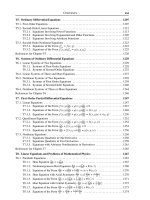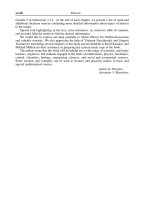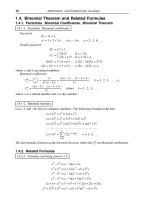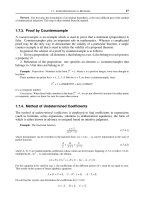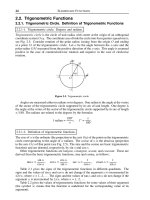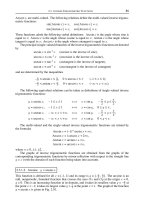Handbook of mathematics for engineers and scienteists part 35 docx
Bạn đang xem bản rút gọn của tài liệu. Xem và tải ngay bản đầy đủ của tài liệu tại đây (399.2 KB, 7 trang )
206 ALGEBRA
The rank of a linear operator A is the dimension of its range: rank (A)=dim(imA).
Properties of the rank of a linear operator:
rank (AB) ≤ min{rank (A), rank (B)},
rank (A)+rank(B)–n ≤ rank (AB),
where A and B are linear operators in L(V, V)andn =dimV.
Remark. If rank (A)=n then rank (AB)=rank(BA)=rank(B).
THEOREM.
Let
A : V→V
be a linear operator. Then the following statements are
equivalent:
1.
A
is invertible (i.e., there exists
A
–1
).
2.
ker A = 0
.
3.
im A = V
.
4.
rank (A)=dimV
.
5.6.1-5. Notion of a adjoint operator. Hermitian operators.
Let A L(V, V) be a bounded linear operator in a Hilbert space V. The operator A
∗
in
L(V, V) is called its adjoint operator if
(Ax) ⋅ y = x ⋅ (A
∗
y)
for all x and y in V.
T
HEOREM.
Any bounded linear operator
A
in a Hilbert space has a unique adjoint
operator.
Properties of adjoint operators:
(A + B)
∗
= A
∗
+ B
∗
,(λA)
∗
=
¯
λA
∗
,(A
∗
)
∗
= A,
(AB)
∗
= B
∗
A
∗
, O
∗
= O, I
∗
= I,
(A
–1
)
∗
=(A
∗
)
–1
, A
∗
= A, A
∗
A = A
2
,
(Ax) ⋅ (By) ≡ x ⋅ (A
∗
By) ≡ (B
∗
Ax) ⋅ y for all x and y in V,
where A and B are bounded linear operators in a Hilbert space V,
¯
λ is the complex conjugate
of a number λ.
A linear operator A
L(V, V) in a Hilbert space V is said to be Hermitian (self-adjoint) if
A
∗
= A or (Ax) ⋅ y = x ⋅ (Ay).
A linear operator A
(V, V) in a Hilbert space V is said to be skew-Hermitian if
A
∗
=–A or (Ax) ⋅ y =–x ⋅ (Ay).
5.6.1-6. Unitary and normal operators.
A linear operator U L(V, V) in a Hilbert space V is called a unitary operator if for all x
and y in V, the following relation holds:
(Ux) ⋅ (Uy)=x ⋅ y.
This relation is called the unitarity condition.
5.6. LINEAR OPERATORS 207
Properties of a unitary operator U:
U
∗
= U
–1
or U
∗
U = UU
∗
= I,
Ux = x for all x in V.
A linear operator A in L(V, V)issaidtobenormal if
A
∗
A = AA
∗
.
T
HEOREM.
A bounded linear operator
A
is normal if and only if
Ax = Ax
.
Remark. Any unitary or Hermitian operator is normal.
5.6.1-7. Transpose, symmetric, and orthogonal operators.
The transpose operator of a bounded linear operator A L(V, V) in a real Hilbert space V
is the operator A
T
L(V, V) such that for all x, y in V, the following relation holds:
(Ax) ⋅ y = x ⋅ (A
T
y).
T
HEOREM.
Any bounded linear operator
A
in a real Hilbert space has a unique transpose
operator.
The properties of transpose operators in a real Hilbert space are similar to the properties
of adjoint operators considered in Paragraph 5.6.1-5 if one takes A
T
instead of A
∗
.
A linear operator A
L(V, V) in a real Hilbert space V is said to be symmetric if
A
T
= A or (Ax) ⋅ y = x ⋅ (Ay).
A linear operator A
L(V, V) in a real Hilbert space V is said to be skew-symmetric if
A
T
=–A or (Ax) ⋅ y =–x ⋅ (Ay).
The properties of symmetric linear operators in a real Hilbert space are similar to the
properties of Hermitian operators considered in Paragraph 5.6.1-5 if one takes A
T
instead
of A
∗
.
A linear operator P
L(V, V) in a real Hilbert space V is said to be orthogonal if for
any x and y in V, the following relations hold:
(Px) ⋅ (Py)=x ⋅ y.
This relation is called the orthogonality condition.
Properties of orthogonal operator P:
P
T
= P
–1
or P
T
P = PP
T
= I,
Px = x for all x in V.
5.6.1-8. Positive operators. Roots of an operator.
A Hermitian (symmetric, in the case of a real space) operator A is said to be
a) nonnegative (resp., nonpositive), and one writes A ≥ 0 (resp., A ≤ 0)if(Ax) ⋅ x ≥ 0
(resp., (Ax) ⋅ x ≤ 0)foranyx in V.
b) positive or positive definite (resp., negative or negative definite) and one writes A > 0
(A < 0)if(Ax) ⋅ x > 0 (resp., (Ax) ⋅ x < 0)foranyx ≠ 0.
An mth root of an operator A is an operator B such that B
m
= A.
T
HEOREM.
If
A
is a nonnegative Hermitian (symmetric) operator, then for any positive
integer
m
there exists a unique nonnegative Hermitian (symmetric) operator
A
1/m
.
208 ALGEBRA
5.6.1-9. Decomposition theorems.
THEOREM 1.
For any bounded linear operator
A
in a Hilbert space
V
, the operator
H
1
=
1
2
(A + A
∗
)
is Hermitian and the operator
H
2
=
1
2
(A – A
∗
)
is skew-Hermitian. The
representation of
A
as a sum of Hermitian and skew-Hermitian operators is unique:
A =
H
1
+ H
2
.
THEOREM 2.
For any bounded linear operator
A
in a real Hilbert space, the operator
S
1
=
1
2
(A + A
T
)
is symmetric and the operator
S
2
=
1
2
(A – A
T
)
is skew-symmetric. The
representation of
A
as a sum of symmetric and skew-symmetric operators is unique:
A =
S
1
+ S
2
.
THEOREM 3.
For any bounded linear operator
A
in a Hilbert space,
AA
∗
and
A
∗
A
are
nonnegative Hermitian operators.
THEOREM 4.
For any linear operator
A
in a Hilbert space
V
,thereexist
polar decom-
positions
A = QU
and
A = U
1
Q
1
,
where
Q
and
Q
1
are nonnegative Hermitian operators,
Q
2
= AA
∗
,
Q
2
1
= A
∗
A
,and
U
,
U
1
are unitary operators. The operators
Q
and
Q
1
are always unique, while the operators
U
and
U
1
are unique only if
A
is nondegenerate.
5.6.2. Linear Operators in Matrix Form
5.6.2-1. Matrices associated with linear operators.
Let A be a linear operator in an n-dimensional linear space V with a basis e
1
, , e
n
.Then
there is a matrix [a
j
j
] such that
Ae
j
=
n
i=1
a
i
j
e
i
.
The coordinates y
j
of the vector y = Ax in that basis can be represented in the form
y
i
=
n
j=1
a
i
j
x
j
(i = 1, 2, , n), (5.6.2.1)
where x
j
are the coordinates of x in the same basis e
1
, , e
n
. The matrix A ≡ [a
i
j
]ofsize
n × n is called the matrix of the linear operator A in a given basis e
1
, , e
n
.
Thus, given a basis e
1
, , e
n
, any linear operator y = Ax can be associated with its
matrix in that basis with the help of (5.6.2.1).
If A is the zero operator, then its matrix is the zero matrix in any basis. If A is the unit
operator, then its matrix is the unit matrix in any basis.
T
HEOREM 1.
Let
e
1
,
,
e
n
be a given basis in a linear space
V
and let
A ≡ [a
i
j
]
be a
given square matrix of size
n × n
. Then there exists a unique linear operator
A : V→V
whose matrix in that basis coincides with the matrix
A
.
THEOREM 2.
The rank of a linear operator
A
is equal to the rank of its matrix
A
in any
basis:
rank (A)=rank(A)
.
THEOREM 3.
A linear operator
A : V→V
is invertible if and only if
rank (A)=dimV
.
In this case, the matrix of the operator
A
is invertible.
5.6. LINEAR OPERATORS 209
5.6.2-2. Transformation of the matrix of a linear operator.
Suppose that the transition from the basis e
1
, , e
n
to anotherbasis
e
1
, ,
e
n
is determined
by a matrix U ≡ [u
ij
]ofsizen × n,i.e.
e
i
=
n
j=1
u
ij
e
j
(i = 1, 2, , n).
T
HEOREM.
Let
A
and
A
be the matrices of a linear operator
A
in the basis
e
1
,
,
e
n
and the basis
e
1
,
,
e
n
, respectively. Then
A = U
–1
AU
or
A = UAU
–1
.
Note that the determinant of the matrix of a linear operator does not depend on the
basis: det A =det
A. Therefore, one can correctly define the determinant det A of a linear
operator as the determinant of its matrix in any basis:
det A =detA.
The trace ofthe matrix of a linear operator, Tr(A), isalso independent of the basis. Therefore,
one can correctly define the trace Tr(A) of a linear operator as the trace of its matrix in any
basis:
Tr(A)=Tr(A).
In the case of an orthonormal basis, a Hermitian, skew-Hermitian, normal, or unitary
operator in a Hilbert space corresponds to a Hermitian, skew-Hermitian, normal, or unitary
matrix; and a symmetric, skew-symmetric, or transpose operator in a real Hilbert space
corresponds to a symmetric, skew-symmetric, or transpose matrix.
5.6.3. Eigenvectors and Eigenvalues of Linear Operators
5.6.3-1. Basic definitions.
1
◦
. A scalar λ is called an eigenvalue of a linear operator A in a vector space V if there is
a nonzero element x in V such that
Ax = λx.(5.6.3.1)
A nonzero element x for which (5.6.3.1) holds is called an eigenvector of the operator A
corresponding to the eigenvalue λ. Eigenvectors corresponding to distinct eigenvalues are
linearly independent. For an eigenvalue λ ≠ 0,theinverseμ = 1/λ is called a characteristic
value of the operator A.
T
HEOREM.
If
x
1
,
,
x
k
are eigenvectors of an operator
A
corresponding to its eigen-
value
λ
,then
α
1
x
1
+ ···+ α
k
x
k
(
α
2
1
+ ···+ α
2
k
≠ 0
) is also an eigenvector of the operator
A
corresponding to the eigenvalue
λ
.
The geometric multiplicity m
i
of an eigenvalue λ
i
is the maximal number of linearly
independent eigenvectors corresponding to the eigenvalue λ
i
. Thus, the geometric multi-
plicity of λ
i
is the dimension of the subspace formed by all eigenvectors corresponding to
the eigenvalue λ
i
.
The algebraic multiplicity m
i
of an eigenvalue λ
i
of an operator A is equal to the
algebraic multiplicity of λ
i
regarded as an eigenvalue of the corresponding matrix A.
210 ALGEBRA
The algebraic multiplicity m
i
of an eigenvalue λ
i
is always not less than the geometric
multiplicity m
i
of this eigenvalue.
The trace Tr(A) is equal to the sum of all eigenvalues of the operator A, each eigenvalue
counted according to its multiplicity, i.e.,
Tr(A)=
i
m
i
λ
i
.
The determinant det A is equal to the product of all eigenvalues of the operator A, each
eigenvalue entering the product according to its multiplicity,
det A =
i
λ
m
i
i
.
5.6.3-2. Eigenvectors and eigenvalues of normal and Hermitian operators.
Properties of eigenvalues and eigenvectors of a normal operator:
1. A normal operator A in a Hilbert space V and its adjoint operator A
∗
have the same
eigenvectors and their eigenvalues are complex conjugate.
2. For a normal operator A in aHilbert space V, there is a basis {e
k
} formed by eigenvectors
of the operators A and A
∗
. Therefore, there is a basis in V in which the operator A has
a diagonal matrix.
3. Eigenvectors corresponding to distinct eigenvalues of a normal operator are mutually
orthogonal.
4. Any bounded normal operator A in a Hilbert space V is reducible. The space V can
be represented as a direct sum of the subspace spanned by an orthonormal system of
eigenvectors of A and the subspace consisting of vectors orthogonal to all eigenvectors
of A.Inthefinite-dimensional case, an orthonormal system of eigenvectors of A is a
basis of V.
5. The algebraic multiplicity of any eigenvalue λ of a normal operator is equal to its
geometric multiplicity.
Properties of eigenvalues and eigenvectors of a Hermitian operator:
1. Since any Hermitian operator is normal, all properties of normal operators hold for
Hermitian operators.
2. All eigenvalues of a Hermitian operator are real.
3. Any Hermitian operator A in an n-dimensional unitary space has n mutually orthogonal
eigenvectors of unit length.
4. Any eigenvalue of a nonnegative (positive) operator is nonnegative (positive).
5. Minimax property.LetA be a Hermitian operator in an n-dimensional unitary space V,
and let E
m
be the set of all m-dimensional subspaces of V (m < n). Then the eigenvalues
λ
1
, , λ
n
of the operator A (λ
1
≥ ≥ λ
n
) can be defined by the formulas
λ
m+1
=min
Y E
m
max
x⊥Y
(Ax) ⋅ x
x ⋅ x
.
6. Let i
1
, , i
n
be an orthonormal basis in an n-dimensional space V, and let all i
k
are eigenvectors of a Hermitian operator A, i.e., Ai
k
= λ
k
i
k
. Then the matrix of
the operator A in the basis i
1
, , i
n
is diagonal and its diagonal elements have the
form a
k
k
= λ
k
.
5.6. LINEAR OPERATORS 211
7. Let i
1
, , i
n
be an arbitrary orthonormal basis in an n-dimensional Euclidean space V.
Then the matrix of an operator A in the basis i
1
, , i
n
is symmetric if and only if the
operator A is Hermitian.
8. In an orthonormal basis i
1
, , i
n
formed by eigenvectors of a nonnegative Hermitian
operator A, the matrix of the operator A
1/m
has the form
⎛
⎜
⎜
⎜
⎝
λ
1/m
1
0 ··· 0
0 λ
1/m
2
··· 0
.
.
.
.
.
.
.
.
.
.
.
.
00··· λ
1/m
n
⎞
⎟
⎟
⎟
⎠
.
5.6.3-3. Characteristic polynomial of a linear operator.
Consider the finite-dimensional case. The algebraic equation
f
A
(λ) ≡ det(A – λI)=0 (5.6.3.2)
of degree n is called the characteristic equation of the operator A and f
A
(λ) is called the
characteristic polynomial of the operator A.
Since the value of the determinant det(A – λI) does not depend on the basis, the
coefficients of λ
k
(k = 0, 1, , n) in the characteristic polynomial f
A
(λ)areinvariants
(i.e., quantities whose values do not depend on the basis). In particular, the coefficient
of λ
k–1
is equal to the trace of the operator A.
In the finite-dimensional case, λ is an eigenvalue of a linear operator A if and only if λ is
a root of the characteristic equation (5.6.3.2) of the operator A. Therefore, a linear operator
always has eigenvalues.
In the case of a real space, a root of the characteristic equation can be an eigenvalue of
a linear operator only if this root is real. In this connection, it would be natural to find a
class of linear operators in a real Euclidean space for which all roots of the corresponding
characteristic equations are real.
T
HEOREM.
The matrix
A
of a linear operator
A
in a given basis
i
1
,
,
i
n
is diagonal if
and only if all
i
i
are eigenvectors of this operator.
5.6.3-4. Bounds for eigenvalues of linear operators.
The modulus of any eigenvalue λ of a linear operator A in an n-dimensional unitary space
satisfies the estimate:
|λ| ≤ min(M
1
, M
2
), M
1
=max
1≤i≤n
n
j=1
|a
ij
|, M
2
=max
1≤j≤n
n
i=1
|a
ij
|,
where A ≡ [a
ij
] is the matrix of the operator A. The real and the imaginary parts of
eigenvalues satisfy the estimates:
min
1≤i≤n
(Re a
ii
– P
i
) ≤ Re λ ≤ max
1≤i≤n
(Re a
ii
+ P
i
),
min
1≤i≤n
(Im a
ii
– P
i
) ≤ Im λ ≤ max
1≤i≤n
(Im a
ii
+ P
i
),
212 ALGEBRA
where P
i
=
n
j=1, j≠i
|a
ij
|,andP
i
can be replaced by Q
i
=
n
j=1, i≠i
|a
ji
|.
The modulus of any eigenvalue λ of a Hermitian operator A in an n-dimensional unitary
space satisfies the inequalities
|λ|
2
≤
i
j
|a
ij
|
2
, |λ| ≤ A =sup
x=1
[(Ax) ⋅ x],
and its smallest and its largest eigenvalues, denoted, respectively, by m and M, can be
found from the relations
m =inf
x=1
[(Ax) ⋅ x], M =sup
x=1
[(Ax) ⋅ x].
5.6.3-5. Spectral decomposition of Hermitian operators.
Let i
1
, , i
n
be a fixed orthonormal basis in an n-dimensional unitary space V.Thenany
element of V can be represented in the form (see Paragraph 5.4.2-2)
x =
n
j=1
(x ⋅ i
j
)i
j
.
The operator P
k
(k = 1, 2, , n)defined by
P
k
x =(x ⋅ i
k
)i
k
is called the projection onto the one-dimensional subspace generated by the vector i
k
.The
projection P
k
is a Hermitian operator.
Properties of the projection P
k
:
P
k
P
l
=
P
k
for k = l,
O for k ≠ l,
P
m
k
= P
k
(m = 1, 2, 3, ),
n
j=1
P
j
= I,whereI is the identity operator.
For a normal operator A, there is an orthonormal basis consisting of its eigenvectors,
Ai
k
= λi
k
. Then one obtains the spectral decomposition of a normal operator:
A
k
=
n
j=1
λ
k
j
P
j
(k = 1, 2, 3, ). (5.6.3.3)
Consider an arbitrary polynomial p(λ)=
m
j=1
c
j
λ
j
.Bydefinition, p(A)=
m
j=1
c
j
A
j
. Then,
using (5.6.3.3), we get
p(A)=
m
i=1
p(λ
i
)P
i
.
C
AYLEY-HAMILTON THEOREM.
Every normal operator satisfies its own characteristic
equation, i.e.,
f
A
(A)=O
.



